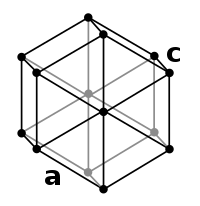
Photo from wikipedia
Photoelectrooxidation of chloride ions to chlorine with co-production of hydrogen by water reduction has been proposed as a means of decreasing the net solar hydrogen production cost. So far, however,… Click to show full abstract
Photoelectrooxidation of chloride ions to chlorine with co-production of hydrogen by water reduction has been proposed as a means of decreasing the net solar hydrogen production cost. So far, however, most such solar-to-chlorine production systems use cost-prohibitive materials and/or show rather small faradaic yield or stability. Here we report the development of earth-abundant, nanostructured bismuth vanadate/tungsten oxide (BiVO4/WO3) photoanode assemblies that operate in acidic sodium chloride solution (pH 1; 4 M) to produce chlorine while generating hydrogen at the dark cathode. We show that electrodeposition of 20 nm WO3 coating protects BiVO4 from harsh pH and oxidative environments while being catalytically active for chlorine evolution. The heterostructured BiVO4/WO3 photoanodes yield average photocurrent densities of 2.5 ± 0.3 mA cm−2 at 1.42 VRHE (Reversible Hydrogen Electrode) under 1 sun illumination. After two hours of continuous illumination, the best performing devices demonstrate faradaic efficiencies of 85% for chlorine production and ~100% for hydrogen production.Photoelectrochemical generation of hydrogen is of wide interest for promoting renewable energy. Here a BiVO4/WO3 photooanode is used to generate chlorine and hydrogen from acidic chloride media with Faradaic efficiency of up to 85% for chlorine and 100% for hydrogen over three hours of operation.
Journal Title: Communications Chemistry
Year Published: 2019
Link to full text (if available)
Share on Social Media: Sign Up to like & get
recommendations!